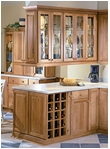Kitchen Culture
 |
Tel:020-36856618, 36815218,36815818 Mobile:18902399586 QQ:340028156 Skype: aredkitchen EMAIL:ared888@126.com |
| Sales Network | |
 |
|
How to choose the right one for your kitchen?
An introduction to basic differences between styles and construction of kitchen cabinets
Is your family one of the estimated 5 million that will be living on pizza and frozen dinners during a new kitchen installation this year? If so, you can speed up the process, make informed decisions and focus your resources wisely by doing your homework early.

Start with your kitchen cabinets--not only will they be your kitchen's most dominant element, they'll probably take longer to get than any other component.
As you begin to shop for kitchen cabinets, you'll discover a nearly overwhelming variety: laminates, hardwoods, veneers, lacquered finishes and much more in hundreds of different styles, configurations and sizes. 

You'll find ready-to-assemble cabinets that can outfit a kitchen for under $1000 and high-end cabinets that cost more than many houses. How do you choose the right ones for your kitchen? The answer is to know what you're looking for before you set out, ask lots of questions and look closely at floor models.
Kitchen cabinet selection
In addition to many sizes, styles, and finishes, it's not unusual to discover that a single company offers more than one cabinet line, each distinguished by different pricing and quality—and up to a dozen different door types.
In addition to many sizes, styles, and finishes, it's not unusual to discover that a single company offers more than one cabinet line, each distinguished by different pricing and quality—and up to a dozen different door types.
Styles typically range from contemporary laminates to traditional hardwoods like oak and cherry. Most companies also offer several finishes on natural woods.
One way dealers can offer a broad selection without carrying an unwieldy inventory is to utilize a "box and door" program. They carry standard-sized cabinet "boxes" and a wide range of door and drawer fronts to fit the boxes.
One way dealers can offer a broad selection without carrying an unwieldy inventory is to utilize a "box and door" program. They carry standard-sized cabinet "boxes" and a wide range of door and drawer fronts to fit the boxes.
Face-frame or frameless kitchen cabinets?
When shopping for cabinets, you'll find two main types: face frame and frameless (or "European-style"). Though some manufacturers make both, most make only one or the other. Despite a trend toward frameless cabinets, about two-thirds of the cabinets made by American manufacturers are the face-frame type.
With a face-frame cabinet, as the name implies, the 1/2- or 3/4-inch plywood or particleboard front edges of the cabinet box are masked with a frame made from 1-by-2 hardwood. The frame adds rigidity to the cabinet and provides a strong base for attaching hinges. Doors or draw fronts normally overlay the frame, but they may be flush or offset. Standard offset hinges are partially visible from the front.
Because the face frame adds rigidity to the construction, face-frame cabinets don't have a top panel or a full back (or the back may be made of quite thin material), but they do have integral bases. When fitting to an irregular wall, the frame around the perimeter can be shaved to fit, and the frame makes it possible to use affordable, low-quality materials for cabinet sides. Unfortunately, the face frame narrows the opening size for doors and drawers.
Frameless European-style cabinets are made up of panels finished on both sides and edged with a simple laminate banding or narrow strip. Most types utilize the "32-mm system." With these, holes are drilled on 32-mm increments vertically along each cabinet side panel. European hinges, cabinet joinery fittings, drawer slides, shelf pins, and other hardware fasten to these holes, providing plenty of versatility and adaptability.
When shopping for cabinets, you'll find two main types: face frame and frameless (or "European-style"). Though some manufacturers make both, most make only one or the other. Despite a trend toward frameless cabinets, about two-thirds of the cabinets made by American manufacturers are the face-frame type.
With a face-frame cabinet, as the name implies, the 1/2- or 3/4-inch plywood or particleboard front edges of the cabinet box are masked with a frame made from 1-by-2 hardwood. The frame adds rigidity to the cabinet and provides a strong base for attaching hinges. Doors or draw fronts normally overlay the frame, but they may be flush or offset. Standard offset hinges are partially visible from the front.

Because the face frame adds rigidity to the construction, face-frame cabinets don't have a top panel or a full back (or the back may be made of quite thin material), but they do have integral bases. When fitting to an irregular wall, the frame around the perimeter can be shaved to fit, and the frame makes it possible to use affordable, low-quality materials for cabinet sides. Unfortunately, the face frame narrows the opening size for doors and drawers.
Frameless European-style cabinets are made up of panels finished on both sides and edged with a simple laminate banding or narrow strip. Most types utilize the "32-mm system." With these, holes are drilled on 32-mm increments vertically along each cabinet side panel. European hinges, cabinet joinery fittings, drawer slides, shelf pins, and other hardware fasten to these holes, providing plenty of versatility and adaptability.
With flush doors and hidden hinges, frameless cabinets have a contemporary construction that is suitable to being covered with wood veneer or plastic laminate. The front edges of each plywood or particleboard box are also covered with a thin banding that matches the panel surface. Frameless cabinets usually have a solid top and back and base units and are commonly mounted on top of a separate plinth or toekick.
Most ready-to-assemble cabinets are frameless. Assembling and modifying frameless cabinets is relatively easy.



